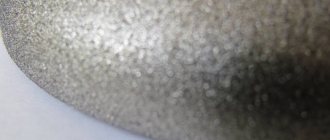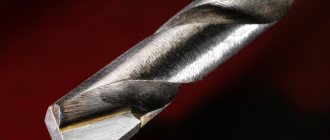Wheels for sharpening tools are not only abrasive (read about vulcanite wheels). Of course, most often these are the ones that are used on sandpapers, since they fulfill the owner’s requirements without any problems. Sharpening a kitchen knife or scissors is no problem. However, there are other types - diamond.
They are also suitable for sharpening home tools, but for a finer finish. It will not be possible to sharpen an ax with such a circle, its grain is too fine. So, diamond wheels are used for sharpening tools; they are used to sharpen hard alloys (brazing on drill bits for a hammer drill, brazing on drills and circular saws for a circular saw).
As you can see, the scope of application is quite large. The advantages of such circles are that they practically do not wear out, one circle lasts for a year or more (depending on the frequency of use). When I was a stone engraver, we used a diamond cup mounted on emery to sharpen pobedite cutters (to cut out patterns on granite) - it lasted for 3 years of use (and we sharpened cutters made of P18 steel every day).
Let's look at the classification of diamond wheels, how to choose the right one, and what to pay attention to. The first is the shape, there are 3 types - cup, plate and straight profile.
Recommendations!
To sharpen manicure and medical instruments, we recommend using non-diamond filler, since it is crystalline carbon and is embedded in steel at high temperatures (the chemical reaction of diamond is caricature). This process makes the workpiece brittle, resulting in chipping of the cutting edge.
It is recommended to sharpen steel cutting tools with diamond wheels based on Elbor (cubic boron nitrite). They do not cause burns.
And the most important recommendation - for diamond and CBN plates - is to use high-speed sharpening machines (2800-3200 rpm), otherwise the diamond-bearing layer will quickly become clogged.
Using our advice, you can choose the right diamond tool for yourself, saving your time and money.
Shallow plate. Marking 12A220
In appearance, the plate differs noticeably from the cup in depth; as a rule, the height is only 18 mm. In the other everything is standard, diamond grinding wheel 12A220 150*10*2*18*32 160/125 - plate with a diameter of 150 mm, width of the diamond layer 10 mm, thickness 2 mm, depth - 18 mm (shallow), fit 32 mm. Grain 165/100 is quite coarse compared to others.
Another note: Metal drills - brief classification
Plates come in 150 mm and 125 mm diameters.
They are excellent for sharpening tools; moreover, they can be used to sharpen carbide tips on circular saws. In order to sharpen such tips, you will need a thin plate so that the edge can fit between the teeth.
Profiles on ceramic bonds
Diamond-nickel coating is used in ceramic bonds.
This coating can be single-layer or can be applied in several layers. The thickness of the ceramic-based binder does not exceed 2/3 the size of diamond grains. Due to the fact that there is a free gap between the tops of the crystals and the bond, chips removed from the surface being processed are automatically removed without creating additional obstacles to the sharpening process. Main properties of ceramic bonded grinding wheels:
- excellent ability to remove a layer of metal during sharpening;
- the ability to create abrasive tools of any configuration;
- high heat conductivity;
- acceptable cost of products.
How to determine the need for sharpening, the degree of wear and decide whether to sharpen or throw away
The working surface of the disk is the teeth-cutters of a certain cutting configuration. Since the disk is a consumable element of the saw, with the amount of work performed, the cutting characteristics of the teeth decrease, and sharpening becomes unsatisfactory.
The following factors indicate that cutters require prompt sharpening:
- It is necessary to increase the pressure of the disk on the surface of the wood to cut and create a cut.
- Smoke appears from under the protective casing and the smell of burning wood is felt.
- The protective cover gets very hot.
- Small sawdust.
Important! The smell of burning indicates that the teeth are not sawing wood, but cutting through it. This leads to an even greater deterioration in the quality of the incisors.
Due to these factors, the following negative consequences occur for a hand-held circular saw:
- Productivity decreases.
- Electricity consumption increases.
- The load on the electric motor and gearbox increases.
This will ultimately lead to device failure.
Characteristics and features of diamond wheels for sharpening cutters
Diamond wheels for sharpening lathe cutters and other cutting tools, depending on the profile shape and type of abrasive, are specifically suitable for the following operations:
- With the shape of a straight flat profile of grade 1A1 - for processing cylindrical products, flat parts and sharpening cutters made of hard structure alloys.
- With the shape of a disc profile 12A2-20* - for sharpening the front part of a tool that has many blades made of hard structure alloys, cutters consisting of assembly units or all-metal, worm-type cutters, circular saws.
- With cup profile shape 12A2-45* - for working with the back and front surfaces of carbide cutters and grinding ends.
- With the shape of a 12R4 disc profile - for carrying out finishing and sharpening operations, as is the case with a 12A2-20* disc.
- With a straight flat profile shape and grooves of grade 9A3 arranged on both sides - for working with cutters made of hard alloys, structural elements of machines, semiconductor structure materials, and measuring tools.
- With the shape of a flat convex-semicircular profile of grade 1FF1 - for sharpening and grinding products made of hard alloys.
- With a flat conical profile on both sides for working with shaped surfaces and threads.
It should be said about the concentration of the diamond component, which has an impact on the sharpening mode. With a 100% performance, the wheels have high productivity and are able to withstand harsh processing conditions without being subject to deformation. With a 50% indicator, discs are most often used for any type of work. At 20% - finishing wheels for manual tool feeding.
2 Device for sharpening turning tools
Sharpening tools involves not only wheels, but also the use of additional devices - boring machines.
Jig boring machines bore, drill, countersink, cut internal and external threads, grind cylindrical surfaces and trim ends.
Tool sharpening machine
A distinctive feature of the machines is a horizontal (or vertical) spindle, which makes axial feed movements. The necessary tool is fixed into the spindle hole - a boring bar with a cutter, a reamer, a drill, a milling cutter, etc.
- horizontal boring;
- coordinate boring;
- diamond boring;
- vertical boring.
Specialized models of jig boring machines:
- Jig boring machine 2D450.
- Jig boring machine 2V440A.
- Jig boring machine 2431.
- Jig boring machine 2421.
2.1 Sharpening technology
- Main back surface.
- Auxiliary back surface.
- Front surface.
- The radius of curvature of the ring.
At the end, the sharpening angles are checked using a template.
Types of sharpening of cutters
To obtain an even and smooth edge, the tool must be constantly in motion along the grinding surface. With this kind of work, the circles will last longer.
The tool can be processed dry or with water. The flow of water must be sufficient and continuous. A dry tool should not be immersed in water, as this may cause destruction of the working edge.
- fine-grained whetstone (technical oil is also used);
- copper wheel (boron carbide paste and technical oil are also used).
Finishing can only be done on cutting tools (edge width up to 3mm).
2.2 Safety precautions
- Do not use grinding wheels whose operation is accompanied by beating.
- The tool rest should be securely fixed closer to the circle.
- Use a tool rest to support the cutter.
- Do not press the cutter too hard (uneven heating can cause cracks; under high pressure the wheel can quickly deteriorate).
- Do not sharpen without a protective guard.
- Wear safety glasses.
- The workplace must have local ventilation.
2.3 Diamond wheel for sharpening tools (video)
The effectiveness of a cutting device depends on the quality and timeliness of sharpening. The latter is due to the fact that with constant use, functional resources are lost over time. Experience over the past decade has shown that the best abrasive tool for this job is diamond sharpening wheels. They process all known types of materials, and product wear is ten times less.
Features of circles on organic bonds
All organic bonds cannot do without filler.
They have weak hardness, resistance to elevated temperatures and conduct heat poorly, but they are characterized by good productivity and high speed of tool sharpening operations. Diamond blades based on an organic component are purposefully used in finishing operations and when performing finishing work. They do an excellent job of sharpening pobedite materials, hard-component alloys, any metals and materials with super-hard structures. Bring the surface to be treated to levels 12 and 11 of roughness class. Discs are less susceptible to greasing, but wear out very quickly.
Sharpening angle for woodworking
The cutters have a working surface that is sharpened at a certain angle. The formation of the angle depends on the material the blade is working with, as well as the performance requirements.
Circular saws are equipped with discs that allow you to cut in one direction or with a reverse movement. For discs with beveled cutters, reverse operation is excluded.
In engineering terminology, the sharpening angle of a cutter is the change in tooth configuration to ensure effective performance when processing wood with the working (cutting) edge of the tooth.
Regardless of how sharpening is performed: manually or on a special machine, the following parameters should be adhered to:
- When cutting wood longitudinally, when its fibers are located lengthwise, a range from 15 to 25 degrees is considered satisfactory.
- For cross cutting, a range of 5 to 10 degrees is relevant.
Important! An angle of 15 degrees is considered universal and is used for any cuts.
In order to effectively sharpen the teeth of circular saw blades, it is necessary to know and take into account another important factor - the density of the surface being processed. Tooth sharpness increases with the softness of the wood and decreases when working with hard wood.
How to sharpen a circular saw with pobedit tips with your own hands
Due to their high strength and hardness, pobedit-tipped cutters can only be sharpened with diamond-coated attachments.
Important! Methods of sharpening a circular saw blade using a grinder (also known as an angle grinder) or files are excluded, since pobedite soldering does not tolerate even the slightest deviation in tooth geometry.
The diamond disk of the machine must adhere evenly and over the entire surface to the cutter. Maintaining a uniform sharpening angle is also mandatory. These requirements are achievable only when using special sharpening devices.
Diamond wheels, design, advantage
Thanks to the physical and chemical properties of diamond and its functional potential, it successfully restores the cutting capabilities of the tool and quickly returns it to working condition. Products of this type are distinguished by cost-effective cutting capabilities and productive dimensional accuracy. These qualities have found worthy use in various spheres of life (industry, everyday life, etc.).
Moreover, diamond wheels, as an abrasive sharpening material, are used for sharpening and finishing cutters, drills, saws, etc. In addition, they are used to process and polish various types of surfaces. The main advantage in their use is simplicity, accuracy, speed and cleanliness of processing. And what is also important, it has little wear and tear - it is durable.
By their design, diamond discs are presented in the form of a body and an applied diamond-bearing layer, which consists of an appropriate powder, a binder and a filling material. The body of the product can be made of black or non-ferrous alloy. polymer. In such circles, two types of diamonds are used: artificial and technical (natural).
Moreover, they are presented in the form of individual crystals or powder. It is known that about 2/3 of the diamonds used in the industry in the form of powder are used for the manufacture of disks, bars and other tools. To hold the diamond powder on the disk, special binders are used that firmly hold the individual granules together.
The manufacturer currently offers the consumer three options for discs on organic, ceramic and metal bonds. The first type of wheel is used for grinding cutting plates and other blanks made of hard materials. They wear out quickly during operation. Discs of the second type are used for finishing tools (cutters, knives, etc.).
Products with metal bonds have sufficient heat resistance, strength and a long service life, but occasional salting is considered a disadvantage; as a result, editing is required.











